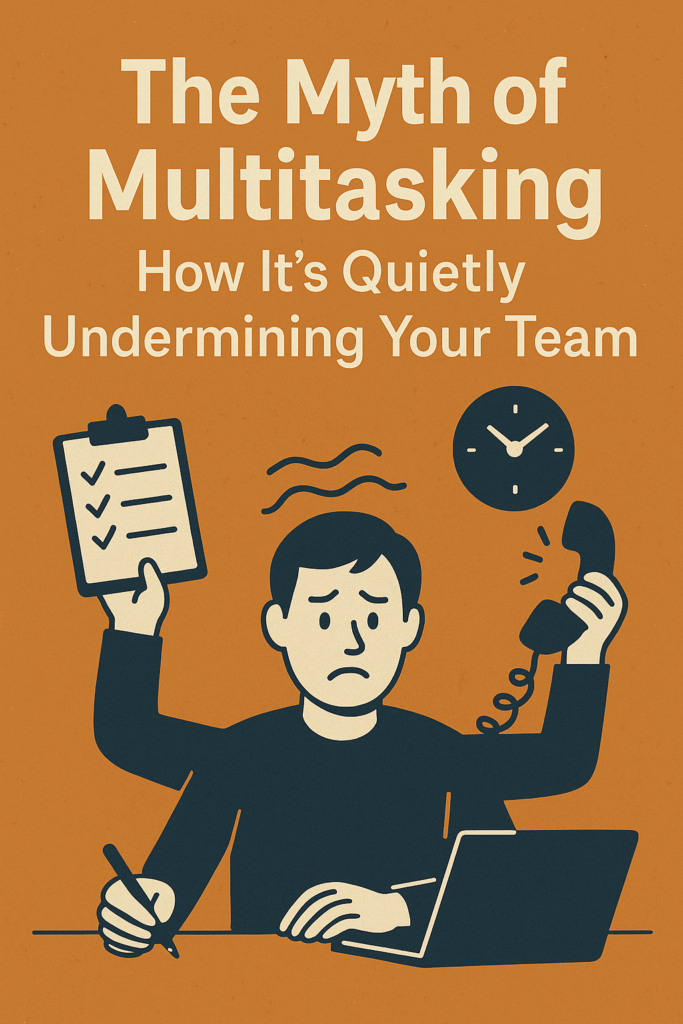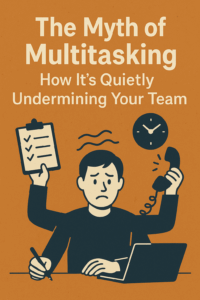It’s the workplace superpower everyone claims but science says doesn’t exist: multitasking. Despite overwhelming research debunking the ability to effectively perform multiple cognitive tasks simultaneously, organizations continue to celebrate and reward apparent multitasking prowess—often without recognizing the substantial hidden costs to productivity, quality, and team wellbeing.
This disconnect between scientific evidence and workplace practice doesn’t just waste resources—it actively undermines the cognitive capabilities that drive innovation, problem-solving, and strategic thinking. Understanding why multitasking fails at a neurological level, how it impacts team performance, and what evidence-based alternatives exist provides leaders with critical insights for thriving in today’s attention economy.
The Cognitive Illusion: What Really Happens When We “Multitask”
The term “multitasking” originated in computing to describe a CPU handling multiple processes concurrently. However, this metaphor fundamentally misrepresents human cognitive function.
Task-Switching, Not Multitasking
Neuroscience research from the Stanford Memory Laboratory demonstrates that what we perceive as multitasking is actually rapid task-switching—the brain toggling between different activities rather than processing them simultaneously.
This switching process involves:
- Goal shifting: “I want to do this now instead of that”
- Rule activation: “I’m following these rules now instead of those”
Each switch requires reorientation of attention and working memory, creating what researchers call a “switching cost.” Studies using functional MRI show distinct neural patterns during these transitions, with activity shifting between different brain regions rather than activating multiple regions simultaneously.
The Quantifiable Switching Penalty
Research published in the Journal of Experimental Psychology quantifies these switching costs:
- Simple task switching reduces productivity by 20-40%
- Complex task switching can reduce productivity by up to 80%
- After interruption, it takes an average of 23 minutes to fully return to the original task
- Frequent switchers show up to 15-point reduction in effective IQ during switching activities
As neuroscientist Adam Gazzaley explains, “The brain is not wired to multitask. When we attempt to perform multiple tasks requiring conscious attention, the brain must rapidly switch between neural networks, creating significant inefficiency.”
Attention Residue: The Hidden Productivity Killer
Beyond immediate switching costs, research published in Organization Science identified a phenomenon called “attention residue”—where attention remains partially stuck on a previous task even after moving to a new one.
This residue:
- Persists for 15-30 minutes after switching tasks
- Reduces performance quality on the new task by 20-40%
- Accumulates throughout the day with each task switch
- Is strongest when leaving tasks unfinished
This explains why a day filled with rapid task-switching often leaves people feeling they’ve been busy but unproductive—they’ve operated at a fraction of their cognitive capacity throughout the day.
The Workplace Impact: Beyond Individual Productivity
While personal productivity suffers under multitasking conditions, the organizational consequences extend much further.
Error Rates and Quality Decline
Research published in the Journal of Management demonstrates that multitasking significantly increases error rates:
- Data entry errors increase by 50% under multitasking conditions
- Conceptual errors in analysis rise by 88% when frequently interrupted
- Writing quality (measured by vocabulary diversity, structure, and clarity) decreases by 30% during task-switching
As Microsoft Research scientist Gloria Mark notes, “When people are constantly interrupted and multitasking, they develop a mode of working that’s highly stressed and not conducive to creative thinking.”
The Collaboration Tax
Beyond individual work quality, multitasking creates what Harvard Business School professor Leslie Perlow calls a “collaboration tax”—the cascading effect of one person’s fractured attention on team effectiveness.
This manifests as:
- Delayed responses creating bottlenecks for dependent work
- Incomplete information processing leading to misalignment
- Reduced meeting effectiveness when participants are multitasking
- Shallow rather than deep engagement with complex problems
Research from the Center for Creative Leadership shows that teams with high multitasking behaviors take 35% longer to complete complex projects than those that implement focused work practices.
The Innovation Impact
Perhaps most concerning is multitasking’s effect on innovation capacity. Studies from MIT’s Sloan School of Management demonstrate that breakthrough thinking requires:
- Sustained attention on problems
- Making unexpected connections between ideas
- Deep rather than shallow processing of information
- Incubation periods for unconscious problem-solving
These precise conditions are systematically undermined by frequent task-switching, explaining why innovation-dependent industries increasingly implement protected focus time despite seeming counterintuitive in a fast-paced environment.
The Attention Economy: Why Modern Work Encourages Harmful Multitasking
Despite evidence against multitasking, workplace systems often inadvertently encourage it.
The Metrics Misalignment
Research from the Wharton School of Business identifies how performance metrics often incentivize counterproductive behaviors:
- Responsiveness metrics (like email response time) reward constant monitoring over focused work
- Activity-based evaluation rewards visible busyness rather than valuable output
- Availability cultures treat immediate responsiveness as a proxy for commitment
These metrics create what researchers call “attention residue traps”—systems that actively pull workers away from deep focus and into fragmented attention patterns.
Technology’s Double-Edged Sword
While digital tools promise productivity enhancement, research from the Nielsen Norman Group shows how they often undermine it instead:
- The average knowledge worker switches between 35 different applications over 1,100 times daily
- Notification systems create an average of 31 interruptions per hour
- Collaboration tools generate 36% more interruptions than they eliminate
- Each platform adds cognitive load through different interfaces and conventions
As technology researcher Alex Soojung-Kim Pang observes, “The problem isn’t technology itself, but how we’ve implemented it without understanding human cognitive limitations.”
The Status Symbol Problem
Perhaps most perniciously, busyness and multitasking have become workplace status symbols. Research from Georgetown University demonstrates that:
- Being “crazy busy” is increasingly seen as a signal of importance and demand
- Appearing constantly connected is interpreted as dedication
- Taking uninterrupted focus time can be perceived as disengagement
This cultural valorization of fractured attention creates powerful social incentives that override both scientific evidence and organizational best interests.
Productivity Myths Debunked: The Multitasking Misconceptions
Several persistent myths sustain multitasking despite evidence to the contrary:
Myth #1: Some People Are Natural Multitaskers
Studies from the University of Utah tested self-described “multitasking superheroes” against average participants. The results:
- Only 2.5% of people demonstrated genuine multitasking capability
- Self-rated excellent multitaskers performed worse than those who rated themselves average
- Perceived multitasking ability inversely correlated with actual performance
As researcher David Strayer explains, “The people who multitask the most are the ones who are worst at it. That’s the alarming discovery.”
Myth #2: Multitasking Improves With Practice
Longitudinal studies from Stanford University examined whether multitasking ability improves with experience:
- Heavy media multitaskers showed worse attention filtering
- Regular multitaskers demonstrated decreased ability to ignore irrelevant information
- Practice reinforced inefficient switching rather than improving simultaneous processing
The research conclusion: practice makes permanent, not perfect, when it comes to multitasking.
Myth #3: Multitasking Is Necessary in Fast-Paced Environments
Research from Harvard Business School challenges the assumption that fast-paced work requires multitasking:
- High-performing emergency room teams demonstrate less multitasking than average performers
- Elite military units emphasize singularity of focus despite high-pressure environments
- Successful startup teams implement focused work systems rather than encouraging task-switching
The evidence suggests that the more consequential and time-sensitive the work, the more important focused attention becomes.
Signs Your Team Is Suffering: The Multitasking Warning Signals
Research identifies several indicators that multitasking is undermining team effectiveness:
The Completion Gap
A widening gap between activity and completion—team members are constantly busy but projects languish unfinished.
Research from the University of California, Irvine shows that high-multitasking environments typically have:
- 37% more projects in progress than focused environments
- 58% fewer projects completed per quarter
- 2.5x longer average project duration
The Creativity Drought
When teams lack breakthrough ideas despite talent and resources.
Studies demonstrate that multitasking environments show:
- 42% fewer novel solutions to problems
- 27% less diversity in proposed approaches
- Significant reduction in transformative versus incremental improvements
The Meeting Multiplication Effect
When meetings proliferate because previous meetings didn’t resolve issues.
Research from Microsoft’s Human Factors Lab shows high-multitasking organizations experience:
- 32% more follow-up meetings for each initial meeting
- 47% longer time to decision on complex issues
- Lower implementation quality of decisions once made
The Exhaustion-Productivity Paradox
When team members feel simultaneously exhausted and unproductive.
Neurological research demonstrates this occurs because:
- Task-switching drains glucose from the prefrontal cortex
- Attention residue creates continuous partial attention that’s cognitively expensive
- The brain expends energy managing multiple cognitive threads without proportional output
Evidence-Based Alternatives: What Actually Works
Research provides clear guidance on more effective approaches:
Time Blocking: The Focused Alternative
Studies from the University of Illinois demonstrate the effectiveness of time blocking—dedicating uninterrupted periods to single activities:
- Knowledge workers implementing 90-minute focused blocks showed 67% higher output on complex tasks
- Quality metrics improved by 32% under time-blocked versus interrupted conditions
- Strategic thinking capacity increased by 23% after implementing focused time blocks
Implementation approaches include:
- Designating specific hours for deep work versus communication
- Creating team-wide focus periods where interruptions are minimized
- Using visible signals (physical or digital) to indicate focus states
Attention Management vs. Time Management
Research from Columbia Business School demonstrates that managing attention provides better results than managing time.
Effective attention management includes:
- Intentional monotasking: Choosing a single task with full cognitive engagement
- Attention state alignment: Matching tasks to current cognitive state (creative, analytical, administrative)
- Context minimization: Reducing environmental triggers for task-switching
- Cognitive transitions: Building specific routines for switching between different work modes
Organizations implementing attention management protocols report 38% higher productivity on complex knowledge work compared to traditional time management approaches.
Batching and Timeboxing
Research published in the Journal of Applied Psychology validates specific techniques:
- Task batching: Grouping similar activities to reduce context switching costs (improving efficiency by 23%)
- Communication timeboxing: Designating specific periods for email and messaging (reducing attention fragmentation by 62%)
- Decision batching: Grouping related decisions to leverage cognitive momentum (improving decision quality by 19%)
These approaches don’t eliminate task diversity but restructure it to work with rather than against cognitive architecture.
Implementation Framework: Creating a Focused Work Environment
Research-based approaches for leaders seeking to address multitasking:
The Three-Level Intervention Model
Studies from the Center for Creative Leadership demonstrate that effective interventions must address:
1. Individual Practices
- Training in attention management techniques
- Personal technology management protocols
- Metacognitive awareness of task-switching triggers
2. Team Norms
- Explicit communication protocols (response time expectations, urgency signals)
- Meeting practices that discourage multitasking
- Shared language around focus states
- Collaborative focus periods
3. Organizational Systems
- Physical environment design supporting focused work
- Technology implementation that minimizes interruption
- Performance metrics that reward quality output over visible busyness
- Leadership modeling of focused work practices
Research shows interventions addressing all three levels achieve 3.4 times better results than those targeting only individual behavior.
The Attention Alliance Contract
One particularly effective approach involves creating explicit team agreements around attention protection:
- Documented shared expectations for communication response times
- Clear criteria for interruption-worthy issues
- Protected focus blocks recognized by all team members
- Visible signals for current attention states
Teams implementing such contracts report 43% reduction in unnecessary interruptions and 37% improvement in complex task completion.
Frequently Asked Questions
How do I balance responsive customer service with focused work needs?
Research from the Wharton Customer Analytics Center indicates this apparent conflict has evidence-based solutions. The most effective approach involves segregating service roles into “responsive” and “solution” functions rather than expecting all team members to perform both simultaneously. Organizations implementing this separation report 32% higher customer satisfaction and 47% faster problem resolution. For smaller teams, time-blocking approaches work well—establishing designated service response periods alternating with focused solution development periods. Another effective strategy: creating clear signal systems for genuinely urgent issues while implementing realistic response time expectations (clear to both team and customers) for non-urgent matters.
What about roles that inherently require monitoring multiple streams?
Certain positions do require managing multiple information inputs—air traffic controllers, emergency dispatchers, and some financial traders. Research from the Human Factors and Ergonomics Society demonstrates these roles aren’t actually multitasking but practicing what researchers call “high-speed serial unitasking”—rapidly shifting complete attention between inputs using highly optimized switching processes. These specialized roles succeed through extensive training in efficiency-of-attention movement, simplified decision protocols, environmental design that minimizes extraneous cognitive load, and regular recovery periods. Organizations can apply these principles to similar roles through procedural clarity, interface simplification, decision support tools, and structured attention recovery periods.
How does this apply to neurodivergent team members who may process attention differently?
Important research from the Center for Neurodiversity at Work shows significant variation in attention processing across neurotypes. While task-switching costs affect everyone, the specific impacts vary. Some neurodivergent individuals (particularly those with ADHD) may actually perform better with certain types of varied stimulation, though still experience costs during complex cognitive task-switching. The key leadership approach involves attention personalization rather than one-size-fits-all policies. This means co-creating individualized work environments, offering flexibility in attention management approaches, and focusing on output quality rather than specific work styles. Teams implementing neurodiversity-informed attention practices report 28% higher innovation outcomes and better retention of cognitive diversity.
How do you measure improvement in focus versus multitasking?
Effective measurement combines both qualitative and quantitative approaches. Research from MIT’s Sloan School of Management validates several specific metrics: “Deep-to-shallow ratio” (time spent on focused versus fragmented work), project completion velocity, “interruption load” (measured through digital tool analytics or sampling), and error rates in complex deliverables. Qualitatively, validated assessment tools like the Attention Management Index and Focused Work Perception Scale provide standardized measurement. The most predictive approach combines these metrics with regular team retrospectives specifically addressing attention quality. Organizations implementing comprehensive measurement show 3.2 times greater improvement than those using anecdotal assessment alone.
How do we implement these changes without falling behind competitors who may still be pushing multitasking cultures?
This question reflects a common but unsupported assumption. Research from the Harvard Business Review examining 300+ companies across sectors found that organizations implementing focused work practices outperformed multitasking-heavy competitors on key metrics: 31% higher profit per employee, 23% better innovation outcomes, and 44% higher talent retention. The transition period does require careful management, including clear communication about the evidence-based nature of the change, phased implementation rather than abrupt shifts, celebrating early wins, and ensuring leadership consistently models the new approaches. Organizations that frame the change as performance enhancement rather than work-life balance generally encounter less resistance, particularly when sharing objective performance data demonstrating improvement.
The Bottom Line: Attention as Competitive Advantage
In an era where what you pay attention to fundamentally shapes what you can achieve, organizations that develop cultures of focused attention create significant competitive advantage. The research provides a clear conclusion: multitasking isn’t a necessary adaptation to modern work demands but a maladaptive response that undermines the very cognitive capabilities most essential for knowledge work.
As Cal Newport, author of Deep Work, observes: “The ability to perform deep work is becoming increasingly rare at exactly the same time it is becoming increasingly valuable in our economy. As a consequence, the few who cultivate this skill, and then make it the core of their working life, will thrive.”
For leaders looking to improve team performance, addressing multitasking isn’t merely about productivity—it’s about creating environments where human cognitive capabilities can flourish, where innovation emerges from sustained thought, and where both results and wellbeing improve through alignment with how our minds actually work.
The organizations that will excel in the coming decade won’t be those that demand more hours, more tasks, or more simultaneity from their people—they’ll be those that successfully cultivate and protect the increasingly rare resource of focused human attention.




